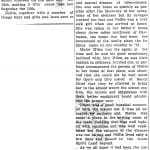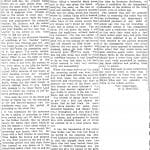The Burial of Nellie Saucy Chief
February 22, 1935
Osage County News
Microfilm Roll: MN00311
On this day in Osage country, the
Osage County News posted an article on the myth surrounding the burial of Nellie Saucy Chief.
The story of the death of Nellie Saucy Chief has been passed down from generation to generation, making the folklore susceptible to change. Here at the research center, one is able to find two different, published, accounts of the story. One being the article in
Osage County News, and the other account is found in the book
Wah’kon-tah: The Osage and the White Man’s Road, written by John Joseph Mathews, an Osage writer
.
Mathews’ account of the burial, recalls Nellie, who at the time might have had an Indian name, as an Osage girl living in Pawhuska. He claims that in her spare time she often visited the Osage Agency, where a Major and his wife resided. While spending time at the Major’s residence Nellie was quick to build a relationship with his wife, who supposedly was the first to call Nellie by her English name. Sooner than later, Nellie began to take great interest in, “the occupations of the young lady of that day, and soon began to wear the clothes of the white woman” (Mathews, 260). After a battle between her two identities, that of her Osage heritage and her new interest in white culture, Nellie eventually “embraced the ways of the white woman and began to feel interested in their heaven” (260). However, this was not the end of her war between the two identities. Nellie, as many young girls, began dreaming of her future husband, but questioning, in her mind, whether her future husband should be of Osage decent or a white man. According to Mathews, it was such turmoil that led Nellie to illness. Her parents took her home, but the Major and his wife frequently visited Nellie. The young girl became very ill. Realizing she was close to death, Nellie asked one last favor of the Major’s wife whom she had become close. Nellie requested for the Major’s wife, “to promise that when she died she would be buried in the beautiful white dress they had made [together], and that she would be buried in the white man’s coffin” (261). A few days later Nellie passed away. After her passing, the Major’s wife shared Nellie’s final wishes with her mother. Reluctantly, her mother followed through, “but thought it was bad that Indian should be placed in the ground where it was dark…but [knew] that her daughter had wanted this,” (262). Nellie’s mother and father stood quietly beside their daughter as the preparations for the burial took place. Worried that her daughter would not be identified as Indian, “in the land of Great Mysteries,” Nellie’s mother made one last request to paint her daughter’s face. The major’s wife agreed and when the burial was over the Saucy Chiefs were left with “no doubt about her identification in the land of Great Mysteries,” (263).
The
Osage County News account reads a bit differently. According to the article, Nelly Saucy Chief was sent to the Indian School in Carlisle, Pennsylvania; although there is no record of her attending the institution. While away at school, Nellie became ill with tuberculosis thought to be caused by the “rigorous and severely damp climate,” of the Northeast. Nellie was sent home early by the school due to her illness to her father’s residence near Pawhuska. Major Miles, and his “missionary inclined wife,” visited Nellie and her family where they requested to, “bring [Nellie] to the school where the school matron, the nurses, and employees with their better equipment could administer the proper care.” Nellie was moved to the school and placed in a well-ventilated private room, “the sewing room,” where they hoped Nellie’s health might improve. Unfortunately, Nellie passed away a few days later. Upon her passing, it was not Nellie’s request, but the Major’s wife that demand Nellie be given a “Christian burial.” To ready Nellie for a proper Christian burial, “the sewing room employees at the school made a beautiful white robe for [her].” Nellie was buried on a cold February day. The ground was frozen and full of snow; Mrs. Saucy Chief watched her daughter buried deep into the ground, contrary to Osage custom. Although in this version of the burial, nothing is done in the actual ceremony to Nellie to connect her back to her Indian roots, such as painting her face; however, the article goes on to say that her parents then went through the traditional mourning customs of the Osage and discussed the process. After describing the customs of Osage mourning, the conclusion of the article reads, “I have digressed to some extent from my story of Nellie in order that I might portray to those who are not informed of the great work done by Major Miles and his splendid wife while in the Indian service.”
While contrasts are found in both stories, there is also a major similarity between the two. From each account, one is able to see the impact of white assimilation on American Indians and a few of the problems that it created. Mathews provides us with an Osage perspective, and the
Osage County News with a white perspective.
Morgan M. Guzman
“The Burial of Nellie Saucy Chief.”
Osage County News. February 22, 1935, p 1 & 2. Microfilm roll number MN00311. Sequoyah National Research Center, Little Rock, Arkansas.
Further Reading
Mathews, John Joseph.
Wah’Kon-Tah. Norman: University of Oklahoma Press, 1932.
Source File(s)
Related Stories
Related Topics
View more stories in
Tags:


